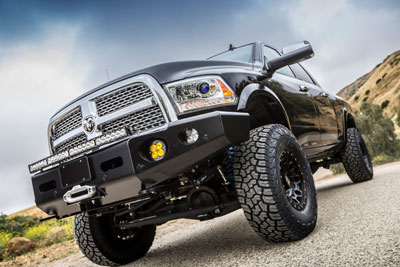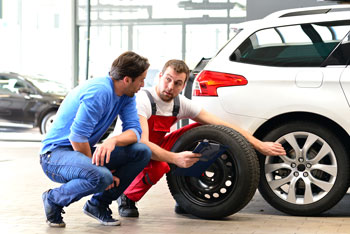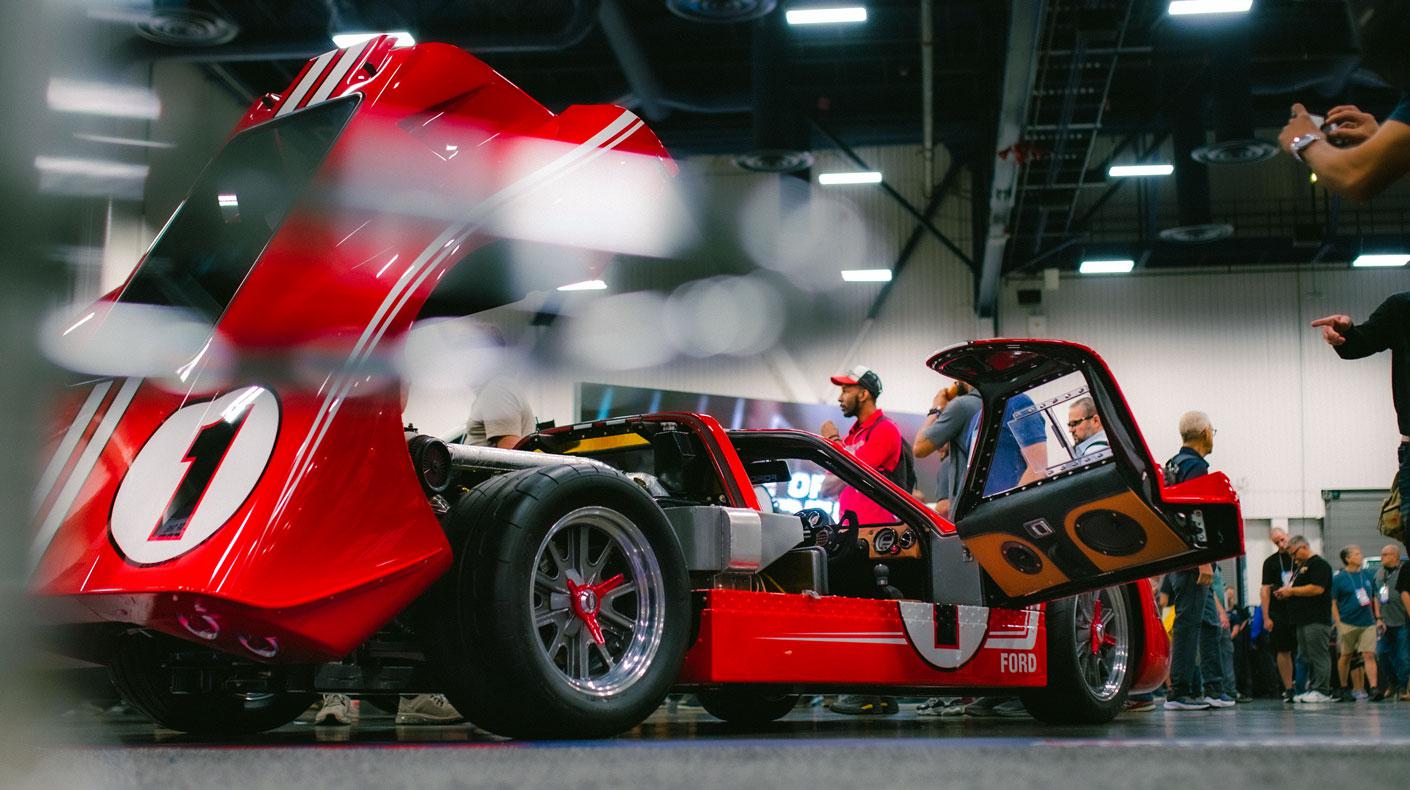SEMA News—February 2020
BUSINESS
Ups and Downs
Deciphering Current Wheel and Tire Market Trends
 Although both the wheel and the tire segments have seen upward trends, a number of factors combined last year for a slowdown in some niches. However, one category that continues to be a winner for wheel and tire makers is trucks—literally so for Yokohama, which captured a 2019 SEMA Show New Product Award for its Geolander X-AT tire. |
Wheels and tires are more than utilitarian objects. The right combination can enhance a vehicle’s performance, increase safety and stability, and even make a fashion statement. All that and more have made them popular aftermarket replacements or upgrades for consumers. Unfortunately, many resellers felt a slowdown in these categories last year. But what caused that slackening in the market? How widespread is it? What might it signal for the future?
Obviously, any forecasts for the wheel and tire industries must be predicated on new-vehicle sales. The “2019 SEMA Market Report” indicates that pickups and SUVs have now regained their former popularity after taking a hit during the recent financial crisis. In addition, crossover vehicles (CUVs) have eclipsed midrange cars as the fastest-selling passenger-vehicle type since 2015. By percentage of new-vehicle market share, pickups lead at 27%, with SUVs and crossovers following at 26% combined. By comparison, midrange passenger cars account for 16% of the market, with upscale and small cars following at 11% and 6% respectively.
In regard to tires, the report estimates market size for performance and special-purpose variants at $2.46 billion, up from $2.19 billion in 2015. The market for off-road and plus-size tires is evaluated at $1.78 billion, up from $1.45 billion in 2015. The custom wheel market has also seen an upward trajectory since 2015, rising modestly from $1.22 billion to $1.32 billion.
Are Tires in a Slump?
While still healthy overall, new-vehicle sales seem to have plateaued in 2019, and tire sales in particular could well follow suit, observed Tyson Boyer, sales director for key accounts with Dill Air Control and chair of the SEMA Wheel & Tire Council (WTC).
“I think the impacts sometimes take a couple of years, but we know that there was rapid growth in sales of new cars and trucks since about 2009 after the recession and then up to about almost the end of 2016,” he said. “SUVs and CUVs really started taking off strong. Now that’s slowing down. Dealers are ordering less, moving inventory that’s sitting on their lots and really becoming more picky about what vehicles they do choose to bring in because of the slower pace. That sets the stage for our next few years of replacement tires in the marketplace.”
Meanwhile, according to Modern Tire Dealer editor Bob Ulrich, recent trade disputes took a more immediate toll on the tire industry.
“Tire sales at the beginning of 2019 were sluggish at best,” he explained. “Tire dealers had full inventories and were suffering because of tariffs on consumer tire imports from China. That has changed, however. Demand is now greater than supply; at least through the end of the year, passenger and light-truck tire shipments are expected to surpass 2018 totals.”
Still, Ulrich said, the market continues to experience ripple effects.
“Chinese tire manufacturers without tire plants outside China’s borders are struggling a bit because of the tariffs,” he said. “As for tire companies with U.S. plants, they have reduced the number of low-cost tires they produce in favor of larger-diameter tires in order to increase profitability. Even the OEMs are favoring 17-in. and larger fitments, also referred to as high value added or HVA tires.
“I would say the strongest tire segment based on new tires and sizes remains the off-road tire segment. That was never more apparent than at the recent SEMA Show. Sales of mud-terrain or M/T tires and rugged-terrain or R/T tires have been steadily increasing for the last four years and were showcased on the Show floor. Being able to take a vehicle off-road—or, equally as important, have it look like it could do so—continues to interest the general public.”
Meanwhile, Boyer noted that mergers and acquisitions within the major tire distribution channels have also shaken up the retail market.
“Two or three years ago, it was rapid with a lot of them,” he said. “It’s still going on, but it seems to have slowed down a little bit in the last year and a half or so. That impacts independents, because they now have to set up more accounts, have more distributors. So there’s a learning and training curve for their teams. They have different portals to log into now, with each one of those tire distribution centers supporting different equipment and supplies. It’s becoming a question of who can get to a simpler process quicker in terms of functionality and usability for independents to order.”
As for the tire products themselves, technologically, tire manufacturers are continuing their push toward ever-lighter and stronger tires to help OEMs meet tightening CAFE standards. Plus, said Boyer, the bigger manufacturers are jockeying to deliver consumers a quality and quantity buying experience.
In just one example at the recent 2019 SEMA Show, Yokohama swept the tire category’s New Products Awards with its Geolander X-AT extreme all-terrain tire, Advan Apex ultra-high-performance tire and Geolandar X-CV tire for luxury SUV and crossover owners. It marked the first time a single tire manufacturer had ever secured the winner and both runner-up spots in the Show awards competition history.
“We were really pleased with the recognition that SEMA bestowed upon us with those awards” said Andrew Briggs, Yokohama Tire vice president of marketing and product management. “It’s a testament to what Yokohama has been and continues to do with regard to new-product development, launch cadence, continuous performance improvements and overall quality. It takes a lot of hard work by a lot of people all over the world to bring a new product to market, so the recognition is hard earned but really appreciated. The new-product award winners were actually only a fraction of what we introduced in 2019. In terms of segmentation, it was important for us to address a variety of needs across multiple categories.”
To that end, Yokohoma’s targets comprised everything from ultra-high-performance competition and summer tires to hybrid all-terrain, premium touring and all-season ultra-high-performance products.
“Some of those were direct replacements for products that were already in our portfolio, and others, like the X-AT and X-CV, were incremental to our business and address new or growing segments,” Briggs explained. “Those new and growing segments also happen to be value-added categories, so they are important for us to have a new and superior offering available.”
Briggs underscored that tires throughout the industry continue to improve, making it important for suppliers like Yokohama to offer a competitive array of quality products across a wide spectrum of categories. What consumers want, he added, can be simply summed up as “more.”
“That could be more longevity, more all-season traction, more fuel efficiency, more dry-weather performance, more options, more durability or more aggressive looks, to name a few,” he emphasized.
While tires have become technologically better over the past decade, improvements have been more evolutionary than revolutionary. That may soon switch, said Todd Steen, executive director of business development at Jackson Marketing Group and an industry veteran who also serves on the WTC select committee. He pointed to radio frequency identification (RFID) chips as one potential game changer.
With the surge in UTV popularity among off-roaders, wheel and tire companies have naturally followed suit. There seemed no end to products boasting tough, aggressive styling at the 2019 SEMA Show. |
Some major manufacturers are currently embedding the chips into their tires for easier tracking and inventory control. However, new sensors may soon be developed to provide extensive data about tire usage and conditions on the road. In theory, consumers and shops will soon be able to “read” the chips to ascertain tread life, the need for rotation and other service-related information. Plus, by tapping into the Internet of Things, manufacturers will also be able to collect data on the actual performance of millions of tires and harness it to design more advanced product down the line.
“Some manufacturers have been using RFIDs since 2012, and there’s an ongoing movement to share that information, which could lead to an explosion of technology,” Steen said. “It’s Bluetooth technology. Go back eight to 10 years, and Bluetooth was something we just connected a speaker to. And look at how many ways we use Bluetooth now. So it’s the evolution or domino effect of technology. Someone’s going to find a way to use that solution to solve their problem, and that’s going to make a light bulb go off for someone else to see how they can solve their problem.”
Boyer also predicted that the latest consumer technologies could have other ramifications for the tire market. For instance, increased ride sharing and shared vehicle ownership made possible through online and cloud-based apps could conceivably dampen wheel and tire customization habits.
“Obviously those apps could reduce the desire for regular car ownership like we’ve all been used to in the past,” he explained. “And with regular car ownership, you know what they always say: One of the first things somebody does—especially to a new vehicle like a truck—is change out the wheels and tires. So this changes that dynamic as well.”
However, he hastened to add, “This is not to be taken as a negative. I think it’s just a changing business model. All of us out there, including independents, need to be aware of it. We need to foresee some of the changes that are taking place so we can adapt and change our business models on the fly.”
Profits from ultra-high-performance tires and luxury wheels were squeezed in 2019 due to trade issues and a tightening of the overall market. However, signs are again indicative of upward growth in the coming year, albeit perhaps slower paced. |
The Shifting Tastes in Wheels
While noting that the ups and downs of the wheel segment often follow the tire market, Voxx Wheels CEO Barry Horlick advised against sweeping generalizations about category trends.
“First, it’s important to understand what segment of the market you’re addressing,” he said. “If you’re talking to off-road guys, it will be totally different than our business. The traditional businesses that we cater to are major retailers. They’re brick-and-mortar retailers primarily in the tire business, which sell our products because it helps them sell more tires.
“If you don’t cater [to consumers] and you don’t have your ear close to the ground, you’re going to miss the opportunities. But that’s what wheels have always been. They’re luxury items. People need a tire; they don’t need a wheel. They already have them on their car—until they bend one. So finding the niches every year where the product is changes. New cars change every year, the calipers change every year, so as a manufacturer, you have to be close to your customers and what’s running through their shops.”
For suppliers, that increasingly includes careful selection of overseas manufacturing facilities amid the uncertainties of economic, trade and tariff issues. Here, the larger, more established wheel companies often have a leg up.
“My 51 years in the industry have taught me how to make a wheel the proper way,” said Horlick. “So we cater to what our customers need, and we build product for their specific needs. That makes it really important for us to understand every manufacturing facility that we contract with, whether it be in China, Thailand, Taiwan or wherever. I think that’s the most important thing. Today there’s a real struggle with duties, and people are looking to get away from the tariffs that are happening, although that might ease up a little bit. But we have done business internationally in a few countries, not just China, for many years. So [during] this tariff situation, we just moved production, much like the
tire companies.”
From his vantage point as president of BBS of North America, a maker of performance street and track wheels, Craig Donnelly sees an overall healthy market.
“But it’s also shifting, meaning that certainly truck is growing, is strong, and will continue, I think, to be that way going forward,” he said. “The area where we play—the high-end performance cars and passenger vehicles—is getting a little tight. It’s transitioning from passenger cars to more crossover-type vehicles. But even though overall for our target audience the potential for us has actually shrunk from a new-car perspective, our business has grown, indicating that our end users like what we’re doing. But the market is changing. A lot of people who buy crossovers are not necessarily wheel buyers. Also, the OEMs offer more and more options for vehicles, so it’s easy for someone buying a vehicle to get an upgraded package straight from them. The aftermarket has to do a better job to stay relevant.”
In BBS’ case, that also has meant knowing its customers inside and out—and picking up market share left behind as other companies shift their focus to trucks.
“We’ve introduced some new products to the marketplace,” Donnelly said. “We try to make sure we’re listening to the marketplace; we’re not just throwing new things out there and seeing if they’re accepted or not. We try to work with our core customer groups and dealers to make sure we’re introducing things that are relevant.”
While the wheel space has long been highly competitive, Donnelly also acknowledged that recent mergers and consolidations are upping the ante.
“They definitely play a part,” he said. “If they have good energy between the companies that are coming on board, they definitely can make an impact. We have to focus and do the best job we can within our group, because we do not have some of the commercial advantages that some other companies might have with being able to shift manufacturing to different countries or locations and consolidating that way. We have production in Germany and production in Japan, so we have to make those operations as efficient as we can to try and be more competitive in our market.”
Perhaps indicative of current category trends, all three 2019 SEMA wheel new-product awards went to off-road or overlanding-themed products. The overall category winner was Topline Products’ VR16-Raid wheel, the company’s latest Chase-series introduction featuring an innovative race wing simulating beadlock design. The Wheel Group/Wheel 1 took the two runner-up positions with its Cali Offroad Gemini and Mayhem Voyager Dark Bronze designs, the latter of which also represents the wider selection of colors and finishes vying for consumer attention.
In fact, Steen predicted further evolution in finishes along with the continuous drive toward lighter, stronger wheels.
“I don’t know the last time I sprayed something on my wheels and it actually streaked,” he said. “Everybody’s getting more durable finishes out there, and that’s only better for the consumer.”
“A lot of the wheel business is fashion-based,” agreed Donnelly. “You can increase sales just by offering a better finish option, and people respond to that visually. Many companies offer 30 to 40 different finishes as options on some of their higher-end forged products, where the range is quite small for us. We offer four to five options on some wheels, and that’s helped us a lot. Even some of our older classic-type wheel designs that are still extremely good for us in the marketplace, like a BBS LM wheel, we’ve offered a new finish in a bronze color, which is kind of a trendy color, but it works well.”
Beneath the finishes, some wheel manufacturers have sought to grab consumer interest with carbon fiber, although the material has yet to catch on with a wide market. For now, magnesium seems to be a favorite among high-end buyers, while alloy continues as the most popular consumer choice.
Amid all the supplier competition, however, most still agree that there’s a niche for everyone in the wheel market. That includes those creating product for the growing side-by-side segment.
“For those of us who want to go out rock crawling or in the sand dunes, UTVs are certainly capable and affordable,” Steen said. “And when you get to that point, aftermarket capitalism is going to follow the trend. Someone’s going to say, ‘I can help them have a better time or aesthetically add the emotion.’”
In other words, the great selling point for wheels is how they appeal to hardcore performance and style enthusiasts alike. As Steen put it: “You may not enjoy the adrenaline fight, but you can get the endorphin spike because they look good.”
For Donnelly, the determinative factor in the market is quality. Regardless of price point or niche, the most successful companies are those “checking all the boxes and paying attention to what they’re doing.”
 Wheel and tire retailers can maximize profits in a tightening market by educating themselves about supplier and technology trends, closely monitoring consumer tastes, and adopting ancillary products and services that enhance their customers’ buying experiences. |
Overcoming Retail Obstacles
Shifting product offerings, a slower-growth market and tighter margins imposed by trade uncertainties undoubtably create challenges for wheel and tire retailers. However, there are several strategies sellers can adopt to boost profits.
One solution is to add ancillary products that enhance the value and satisfaction that consumers derive from their wheel and tire upgrades. If those products encourage customer recruitment and retention, all the better. At least that’s the thinking of Patrick Fletch, AlloyGator director of business development in North America.
A British company and recent SEMA Show exhibitor, AlloyGator makes a nylon protection product designed to defend wheel rims and tire walls against curb damage. In a departure from other rim protection products, however, the AlloyGator stripping fits securely between the wheel and tire courtesy of tiny, gripping teeth and so calls for professional installation, Fletch said.
“The biggest and most important part that I love about the product is the retention side,” he said. “If I’m a tire or accessory shop or dealership and I put this product on a car, the owner is more likely to come back to me.”
AlloyGator is currently at work expanding its network of trained retail partners in the United States. Consumers can order the product in a variety of colors online from the company, then locate an installer through the site and receive a discount on their orders.
Another strategy for wheel and tire installers is to improve their outlet’s operations in attracting and retaining customers via enhanced software. One software supplier, ASA Automotive Systems, used the 2019 SEMA Show to announce the launch of a new digital division to help independent tire and auto service dealers attract more online customers and retain them with a suite of new digital tools.
Staffed by industry experts, the new division will offer a range of scalable products and services, including digital and content marketing, social media, mobile-optimized websites, search-engine optimization and advertising assets to enhance consumer experiences in-store and beyond. The company believes that its services can revolutionize the manner in which operations of all sizes deal with customers.
“ASA digital is an important expansion of our company’s product line, which will address a critical need in the industry currently being underserved and perfectly complements our core shop management software business,” said Dave Vogel, ASA Automotive Systems general manager.
However a retailer accomplishes it, staying engaged with customers and what’s trending among them will be especially critical for wheel and tire sellers in the coming year.
“There are so many segments in the market,” Donnelly said. “As far as the retailers go, it’s a lot to keep up with. They should be active in some cars-and-coffee events and things like that in their areas and try to get to know more about the community, what’s going on there, and bring some of that business into their locations.”
Steen emphasized the need for retailers to also keep abreast of emerging technologies, notably advanced driver-assistance systems, which can malfunction with the wrong wheel and tire combinations or improper alignment and recalibration procedures.
“We’ve got to not only train the dealers and installers to do [proper] alignments on tires and sensors but also train the general public that they’re going to have to do this,” Steen said. “It’s going to be a reality for people in less than 18 months, because every new car out there being sold on the line today is going to need tires in the next 18 to 24 months.”
Horlick also underscored the need for wheel sellers to educate themselves about the market.
“You need to know what’s really happening in a global economy,” he said. “We’re in a global manufacturing situation. Take the time, read some things, and understand what’s happening in the world that can affect your business.”
To that he added: “Make sure your sources are good. Make sure that their product liability insurance is good. I don’t think many companies have recall insurance, but we do. The bigger wheel companies do make sure of that. You want to have good availability of product from your source and understand what’s going to happen in the marketplace.”






